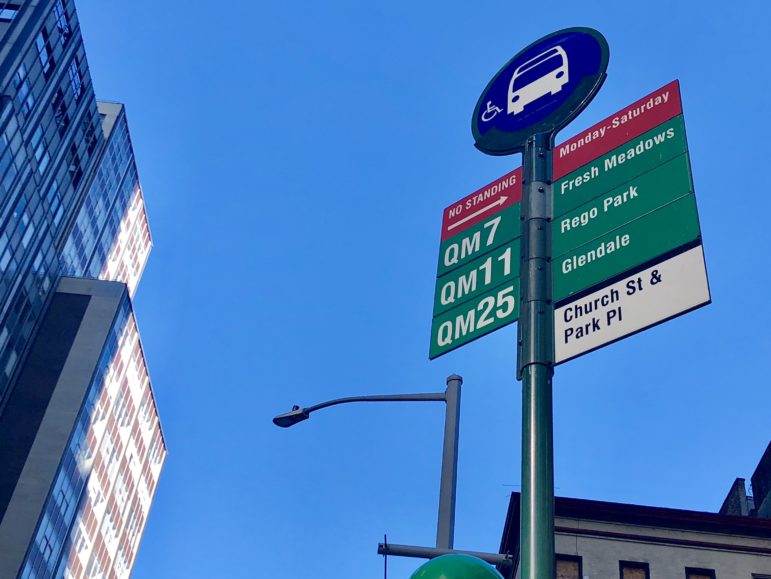
Jeanmarie Evelly / City Limits
An express bus stop in lower Manhattan.
Congestion pricing, the proposal to charge vehicles a fee to drive into Manhattan below 60th Street, would do more than just raise revenue for the struggling subway—it could cut commutes for some Brooklyn and Queens bus riders by one to two hours a week, according to a report released Tuesday.
Transit advocacy group Riders Alliance analyzed how congestion pricing would impact commute times for express bus riders, and found the policy would shorten start-to-end trip times on 39 express routes in Brooklyn and Queens by between 37 minutes a week and as much as two hours, depending on the line. The congestion fees would discourage drivers from making “unnecessary” trips into Manhattan, reducing the number of cars on roads and speeding up travel times, Riders Alliance says.
The analysis—based on experts’ estimates that congestion pricing would speed up traffic in Manhattan’s central business district by 20 percent, and by 7 percent in areas around it—found that the policy would especially benefit riders in the city’s “transit deserts,” where subway service is scarce or non-existent. Some express bus riders, who pay $6.50 per trip, regularly trek more than 90 minutes each way to work, making them “super commuters” under the U.S. Census Bureau’s definition of the term.
Riders who take the BM1 bus route from its start point in Mill Basin, Brooklyn, for example, currently face a one hour and 44 minute commute to the end of the line in midtown Manhattan. If congestion pricing were in place, their rides would be trimmed by nearly 9.49 minutes each way, totaling one hour and 35 minutes per week, according to Riders Alliance.
A ride on the X63 bus from the start of the line in Rosedale, Queens, now takes a daunting two hours and three minutes to get to midtown, a trip that would be shortened by nearly 12 minutes a day—or two hours a week—under congestion pricing, the group says.
“It’s a meaningful amount of time,” says Danny Pearlstein, Riders Alliance’s policy and communications director. “It’s something that congestion pricing could bring to people who live in neighborhoods that are far from the subway.”
Improving city bus service is a priority for New York City Transit President Andy Byford, and comes at a time when the MTA is dealing with declining bus ridership and complaints that the system is slow and unreliable.
If congestion pricing were in place, drivers who want to avoid paying the fees might opt for the bus instead. And while that might mean more crowds on your local or express routes, the MTA could easily adjust service to accommodate the shift, Pearlstein argues.
“Luckily, it’s easy for the MTA to add capacity to bus routes that grow in popularity; they can run existing buses more frequently or even buy new buses,” he said in an email, noting that the authority is already testing out the use of double-decker models on some Staten Island express lines.
Riders Alliance has not yet analyzed how congestion pricing would impact express bus service on Staten Island or the Bronx, but they predict the time savings would be similar, Pearlstein says.
“Staten Islanders have the longest commutes in the country. Some people get on the bus at 6 a.m. and don’t get to work until 9 o’clock,” says Sen. Diane Savino, who represents the borough and parts of Brooklyn and co-sponsored a bill to implement congestion pricing via the MoveNY plan.
“Just getting through Brooklyn into lower Manhattan—an 11-mile ride can take you an hour and a half. It’s absurd,” she added.
Transit advocates have been pushing hard for the last several years for the state to implement some form of congestion pricing, and many were disappointed when the legislature failed to include a comprehensive version in its final budget this past spring.
Organizations like Riders Alliance are making the issue a priority as lawmakers get ready to return to Albany for the 2019 session, and even Gov. Andrew Cuomo has called congestion pricing the “only option” to raise funding to fix and modernize the struggling subway system.
“Congestion pricing is not just about the subway,” Pearlstein says. “The fact is, the subway doesn’t completely cover the city, and in the neighborhoods on the outer edges of the city where there are no subway stops, there are express bus stops.”








